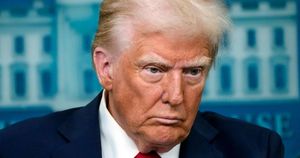Donald Trump has officially announced the introduction of significant tariffs on imports from Canada, Mexico, and China, signaling the administration's intention to bolster its enforcement against illegal immigration and drug trafficking at the southern border. Effective from Saturday, February 2, 2025, Trump will impose 25% tariffs on goods imported from Canada and Mexico, alongside 10% tariffs on those sourced from China.
Speaking on the afternoon of February 1, White House press secretary Karoline Leavitt confirmed the implementation details, stating, "Starting tomorrow, those tariffs will be in place. These are promises made and promises kept by the president." This marks yet another decisive step by the Trump administration to leverage trade policies for broader political goals, primarily concerning immigration and drug smuggling.
During this latest Oval Office address, Trump defended his position by asserting there were no avenues for Canada, Mexico, or China to halt the tariffs once initiated. He emphasized his commitment to addressing what he perceives as inadequate action from these nations against the smuggling of fentanyl and other narcotics, which have been devastating American communities.
Trump's tariffs are part of a broader economic strategy aimed at utilizing trade policy as leverage over foreign nations. The president suggested he could mitigate the effects on oil imports through potentially reduced tariff rates, indicating there might be flexibility within his plan to cushion any economic backlash.
Como parte de estos esfuerzos, Trump left the door open to considering additional tariffs on the European Union and other targeted sectors including energy, metals, pharmaceuticals, and semiconductors. He reiterated the importance of these measures, signaling the administration's readiness to escalate its trade disputes if deemed necessary.
The reaction from economic experts suggests the tariffs could lead to swift price increases for American consumers, as costs imposed on manufacturers often trickle down to the end-user. Trump did not shy away from acknowledging these potential consequences, conceding, "there could be some temporary short-term disruption, and people will understand." Such admissions reveal the administration's awareness of the delicate balance between protective trade policies and the economic realities faced by everyday citizens.
This development marks yet another chapter in the history of Trump's controversial trade policies, characterized by protectionist themes and confrontational stances toward U.S. allies. Despite the potential for economic retaliation, Trump maintains his hardline approach is necessary for the country's long-term benefits.
With looming questions about the durability of these tariffs and their potential ramifications on domestic markets, economists and consumers alike remain on alert for the widespread effects as these policies begin to take effect. Industry analysts will closely monitor sectors directly impacted by the tariffs, anticipating shifts not only economically but also politically as the 2026 midterm elections approach.
For Canadian and Mexican businesses heavily reliant on exports to the U.S., the tariffs present significant challenges. Stakeholders are left to wonder how these changes will affect their competitiveness and ability to navigate the U.S. market without incurring excessive costs from tariffs. Mexico, for example, has already expressed concerns over the potential fallout and is considering measures to counteract these tariffs.
Meanwhile, Trump's steadfast allegiance to tariffs reflects his administration's broader strategy rooted in nationalism and the belief in protecting American jobs from foreign competition. He remains undeterred by critics who argue such protectionism could harm the broader economic framework and U.S. relationships on the global stage.
The global economic community is poised to respond, weighing the potential for trade wars driven by retaliatory tariffs from affected nations. Economists caution against future escalations, emphasizing the need for diplomacy over unilateral economic measures.
One clear takeaway from Trump's recent announcements is the persistent tension between trade, immigration, and drug policy. The administration continues to frame these tariffs as not merely economic decisions but as part of their broader mission to combat illegal drug trafficking and bolster national security.
Going forward, the impact of these tariffs will be closely monitored by various sectors, as businesses try to adjust to the new trade realities. The success or failure of this heavy-handed approach remains to be seen, but for now, the administration is clearly betting on tariffs as their preferred means of influencing international behavior.



